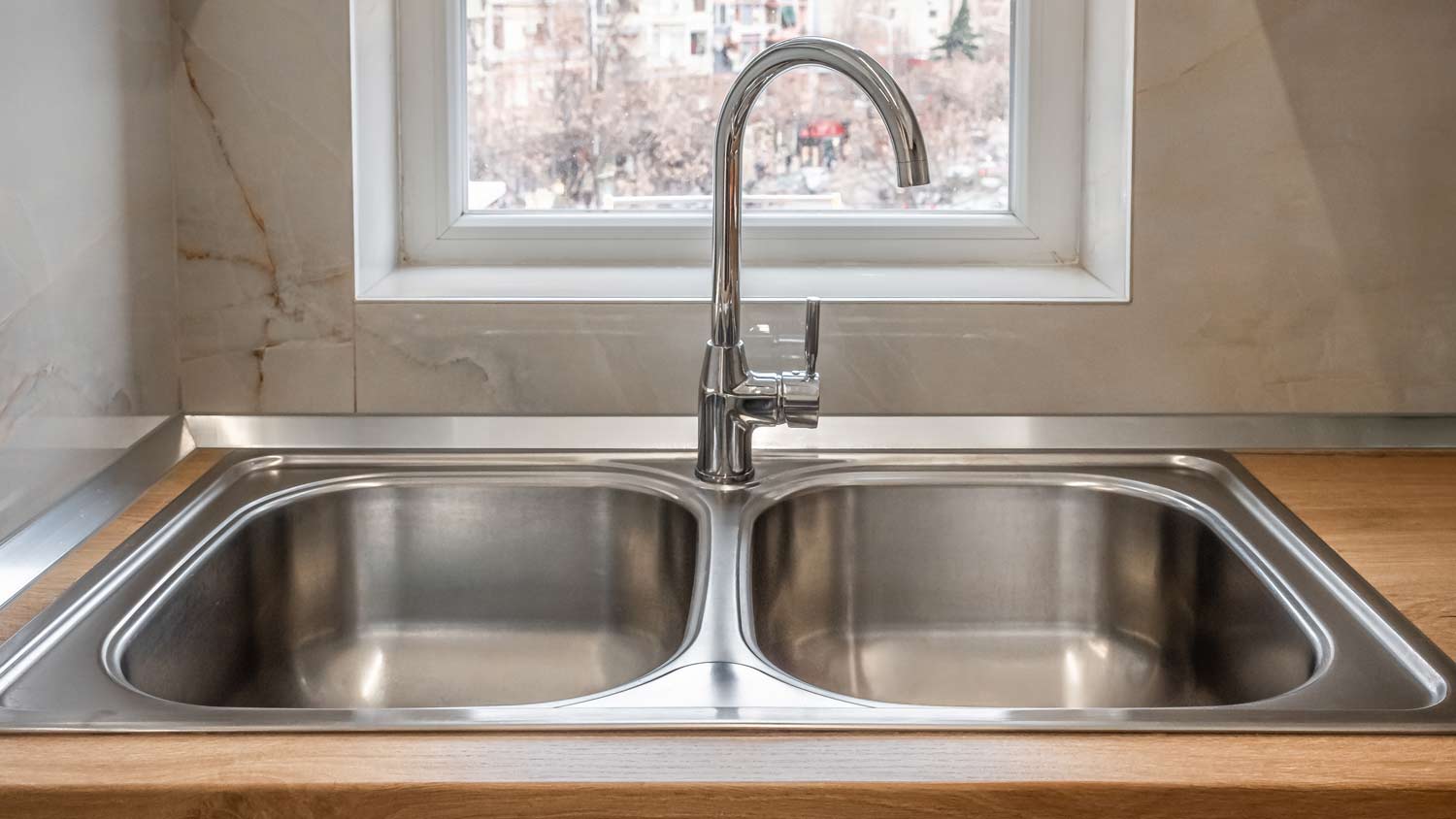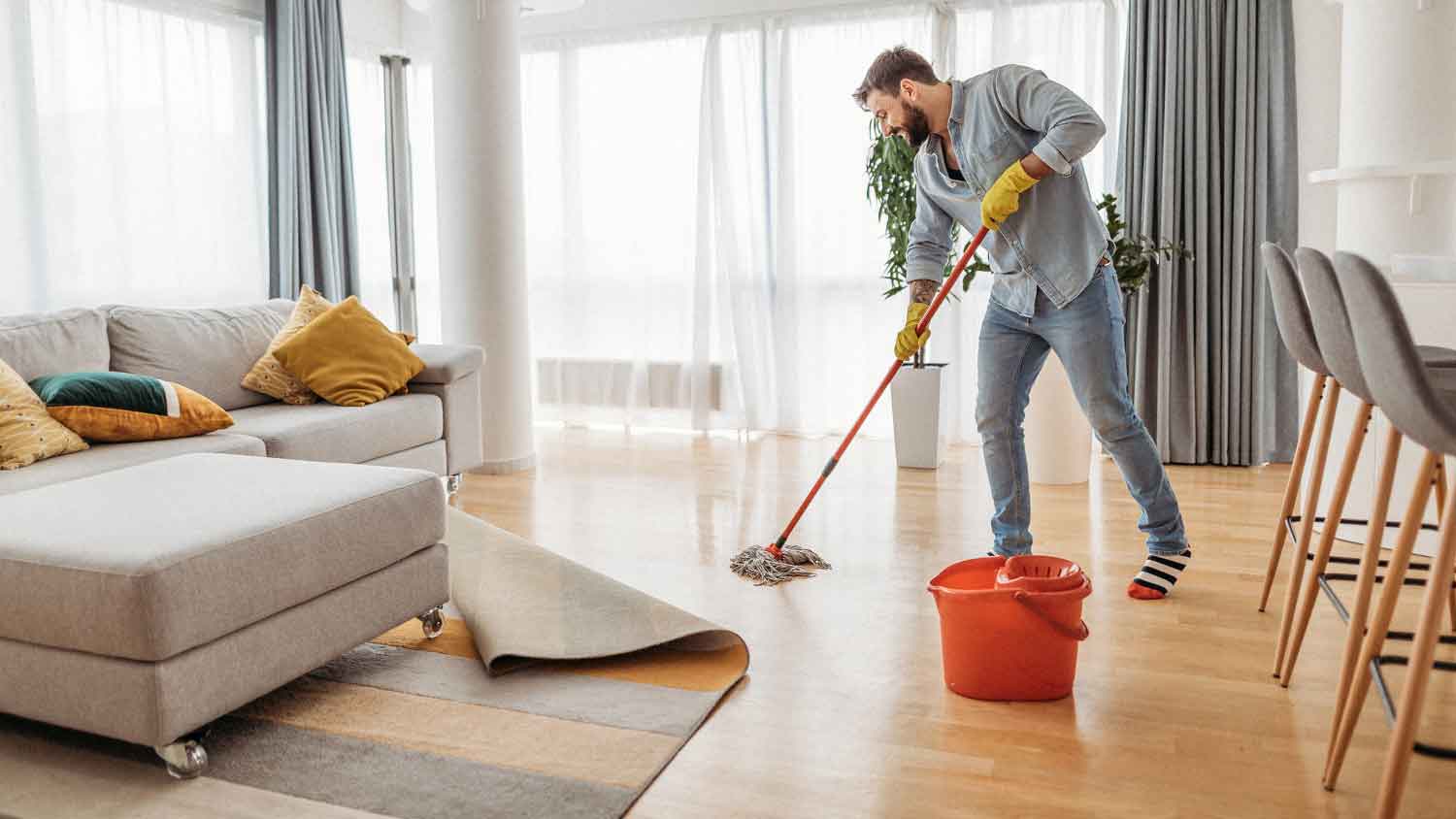How to Remove Adhesive From Wood in 6 Ways
Don’t get stuck with sticky spots that can damage the wood in your home


Wood flooring, furniture, and fixtures are some of the hardest working parts of our homes, but it can be difficult to keep them clean. Sticky residue on these surfaces from glue, stickers, or other types of adhesive can be more than annoying—it can damage the wood and lead to expensive refinishing costs. Use these simple methods to learn how to remove adhesive from wood surfaces for good.
Why Do I Need to Remove Sticky Residue From Wood?
Nobody likes to look at an old sticker stuck to the back of their kitchen table or feel a sticky spot on their bare feet when walking across a wood floor, but is it necessary to remove? It is if you want to preserve your wood and keep it from being damaged. Learning how to clean sticky floors, and other wood surfaces, can keep your wood in good condition and prevent unsightly residue marks that collect dust and dirt.
Adhesive can soften and pull up the finish on wood surfaces. The longer you leave it, the more likely it is that the sticky residue will bind to the finish, making it harder to remove without further damage or staining. To minimize damage, remove sticky residue from wood as soon as you notice it.
Prepping to Remove Sticker Residue From Wood
Before getting started, it’s a good idea to know what type of wood you’re dealing with, and how it’s finished. Some methods of removing sticky residue may damage the wood’s finish, so performing a patch test on an inconspicuous area can save you from any unpleasant surprises during the removal process.
How to Remove Sticky Residue From Wood

Maybe your child put a sticker on your antique wooden table that just won’t budge no matter what you do. Sometimes a stubborn stain needs a firm hand. The following are stronger approaches to removing sticky residue—but they may damage wooden surfaces, including cabinets, hardwood floors, and tables. Proceed with caution.
Commercial adhesive-removal products are usually made of the same materials found below. If you choose to use one of these, make sure the product is safe for wood and follow the manufacturer’s instructions.
Steam Cleaner, Hair Dryer, or Heat Gun
Use the small steam nozzle on a steamer or the low setting on a hair dryer or heat gun to loosen up the goo.
Use it for no more than 30 seconds at a time, and keep the heat source moving to avoid overheating the area.
Wipe or scrape it off with a soft rag or roll the sticky residue off using your fingers.
Plastic Scraper and Pencil Eraser
This tactic is one way to remove stickers from wood. You’ll need some sort of plastic scraper, like a credit card or the top of a plastic knife (the non-blade side), and an eraser to help you roll the adhesive away from the surface. Make sure the tool is firm enough to scrape up adhesive, but not sharp enough to damage the surface. If the wood is still sticky once the visible adhesive is removed, finish with one of the methods below.
Use your plastic scraper to gently scrape the sticker away from the wood surface. Keep in mind that repeated scraping can damage the finish, so proceed with caution. And even if the sticker is tough, don’t use a putty knife or metal blade.
Use a pencil eraser to wipe away the sticker adhesive. Simply erase over the areas that feel sticky, and the adhesive should roll off in clumps.
Clean the area by washing it with a mixture of hot water and a few drops of liquid dish detergent. You can use the rough side of the sponge to scrub away any remaining residue.
Dry the surface entirely after cleaning it with a dish towel. If there’s still sticky residue left behind, revert to one of the more aggressive methods listed below.
Oil
This method applies to WD-40, baby oil, vegetable oil, furniture polish, mineral oil, and really any oil-based substance. Before using any oil or polish, test it on an inconspicuous area. This method can soften or pull your finish or cause haloing and mooning, and it may prevent any future refinishing from sticking. This will also likely lift any wax surfacing from the floor.
Apply the oil to a soft cloth.
Scrub the sticky area. You may need to let the oil sit for up to two hours and/or apply heat using a hair dryer.
Clean the surface with a wood cleaner or a mild soap and water mixture.
Vinegar
Soak a cloth with vinegar or, for a gentler approach, use a solution of 1/2 cup of water and 2 teaspoons of white vinegar.
Wring the cloth out and wipe the wood surface.
Work slowly, giving the adhesive time to soften.
Roll the goo up with your fingers or scrape it off.
Clean the area with a wood cleaner.
Paint Thinner (Mineral Spirits)
Note that this method will strip away any wax.
Apply with a slightly dampened rag or a nonabrasive nylon cleaning pad with a fine surface.
Quickly rub it off.
Wipe the floor with a wood floor cleaner and damp rag.
Nail Polish Remover
This method may remove finish from the wood, so use caution or only use it on unfinished wood.
Apply a small amount to a cotton ball or swab.
Rub it gently over the residue in a circular motion, but don’t apply the solution beyond the residue.
Wipe with a dry cloth.
Wipe with a damp cloth.
Tips for Dealing With Sticky Residue on Wood
Sometimes removing adhesive from wood isn’t a straightforward process. If you use an aggressive method on stubborn stickiness, you may end up with a dull spot or stain on the finish. In this case, you might have to touch up the finish or completely refinish the wood. To avoid damage and effectively solve the issue, try these tips:
Mind your chemical adhesive remover: Don’t use a chemical adhesive remover that can soften the finish. Use a gentle solution and read the manufacturer’s directions before applying.
Don’t use too much heat: You may want to use a blow dryer to soften glue before removing it, but it can cause the wood’s finish to bubble. Make sure you constantly move a blow dryer rather than concentrate the heat in one area, and ensure your finish can handle heat before you begin.
Peel the sticker or adhesive slowly: If you can peel up the sticky residue because it’s formed a film, peel slowly to avoid pulling up the finish.
Don’t use a metal blade as a scraper: A metal putty or butter knife can scratch the finish if you’re using it to scrape off sticky residue. Choose firm plastic tools that have a little bit of give in order to prevent damage.
Abrasive cleaning supplies like baking soda, steel wool, and nylon-coated sponges can permanently scratch surfaces. If you need a deep clean, a cleaning pro will have the right supplies to get your space sparkling and avoid damage.
DIY vs. Hiring a Pro to Remove Sticky Residue
Most homeowners can remove sticky residue on their own unless you’ve spilled a large amount of adhesive, the adhesive is particularly stubborn, or you’re working with a fragile antique or high-end piece. In this case, you may want to hire a local furniture cleaner or local house cleaning service. These types of pros will have solutions for the toughest sticky residue on the most fragile surfaces.
The cost of professional cleaning services is typically $30 to $50 per hour, but it can cost as much as $80 per hour for a specialized service in an area with a high cost of living. Most homeowners spend $100 to $250 on a cleaning service.
Frequently Asked Questions
Wood furniture gets sticky when dirt and grime accumulate on the surface. Sometimes, wax coatings and oils are the culprit, but other times, it’s a sign that the finish is failing, and no amount of cleaning your wood furniture will help. Varnish and lacquer can both get sticky as they age, and in this case, you’ll need to refinish the wood to stop the issue.
Yes, vinegar can break down the adhesive bond, effectively dissolving the glue from wood. It will be much easier to wipe away. Vinegar’s acidity, which helps to make it an effective all-purpose cleaner, can also aid in removing adhesive with less chance of damaging the wood and finish than more aggressive solvents.
WD-40 is an effective way to remove glue and other sticky residue from many surfaces, including wood. Spray the WD-40 on the area, allow the product to sit for a few minutes, then carefully wipe away the residue. As with other adhesive removal methods, test the WD-40 on an inconspicuous spot first to ensure it won’t damage the finish.





- How to Clean Sticky Floors 5 Ways
- How to Waterproof Wood With 3 Simple Methods
- How to Fix Water-Damaged Wood Furniture
- How to Remove Stickers From Glass: 8 Foolproof Methods
- How to Remove Paint from Wood: 7 Methods to Try
- 9 Great Tips for Refinishing Your Hardwood Floors
- Wood Stain vs. Paint: Which Is Right for Your Next Project?
- 7 Types of Hardwood Flooring Finish to Protect Your Investment
- How to Repair Rotted Window Frames and Make Them Look Brand New
- Can You Paint Over Stain? Here’s What to Know










